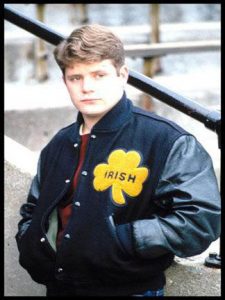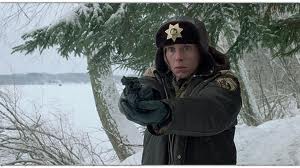
 "Captain Phillips" captivated audiences recently by telling a true story of heroism with heart-stopping realism. Director Paul Greengrass was dedicated to authenticity, going so far as to film on actual boats at sea, rather than the comfort of a controlled set. What resulted was a harrowing depiction of one of the most heroic and brave men we've ever seen. But if you've seen the news lately, you may be aware that the real Captain Phillips' heroics are being questioned by his crew. They claim that the Captain unnecessarily put their lives in danger, despite blatant warnings about pirates off the Somali coast.
"Captain Phillips" captivated audiences recently by telling a true story of heroism with heart-stopping realism. Director Paul Greengrass was dedicated to authenticity, going so far as to film on actual boats at sea, rather than the comfort of a controlled set. What resulted was a harrowing depiction of one of the most heroic and brave men we've ever seen. But if you've seen the news lately, you may be aware that the real Captain Phillips' heroics are being questioned by his crew. They claim that the Captain unnecessarily put their lives in danger, despite blatant warnings about pirates off the Somali coast.
"Captain Phillips" isn't the only one taking heat, as Julian Assange has been actively speaking out against the new film "The Fifth Estate". The film chronicles Assange's controversial rise to prominence as a spiller of government secrets. The WikiLeaks founder has even reached out to star Benedict Cumberbatch to tell him that while he thinks he's a fine actor, he wishes he wouldn't take part in a movie that eschews the truth so much.
Whenever audiences see the disclaimer "Based On A True Story" on a film, they usually acknowledge that liberties have been taken with the story in the interest of entertainment. There are countless movies that have taken inspiration from real events but fudged the details, but we would like to highlight a few that we think are particularly egregious.

Lots of "true" movies fabricate a villain in order to make things more interesting. Ron Howard's "Cinderella Man" played up the aggression of boxer Max Baer, who in reality was a well-liked man that was very remorseful for the death of one of his opponents in their match. James Cameron's "Titanic" turned First Officer William Murdoch into a murderer when he shot Tommy Ryan, an account which never happened and which angered Murdoch's family. But one can't help but look at an uplifting film like "Rudy" and not believe how manipulative it is. In the film, Daniel "Rudy" Ruettiger is a runt that wants with all his heart to play for the Notre Dame Fighting Irish. He worked his little heart out and earned a place on the practice squad, but never got the chance to take the field come game time. Coach Dan Devine refused to let Rudy play, and it wasn't until the entire Notre Dame team staged a heartwarming protest that Devine buckled. Unbelievably, when Rudy was put in at defensive end for one play in the last game of the season, he recorded a quarterback sack.
But that's all nonsense. In actuality, it was Devine's idea to dress Rudy for that final game. He agreed to let the filmmakers paint him as a bit of a bad guy, but was shocked to see just how mean they made him. The man that made it possible for Rudy to get that sack in the first place was turned into a heartless jerk, just so we would appreciate the emotional victory even more.
 There have been ten movies about the hauntings that took place at the Amityville Horror House. While it is true that resident Ronald DeFeo killed six of his family members there, all of the hauntings that reportedly occurred afterward have been debunked. The paranormal investigative team of Ed and Lorraine Warren, who were the basis for this year's hit "The Conjuring", insist that the house is actually haunted, but none of the recent residents have substantiated these claims. I can actually speak from experience here, as I have actually been inside the Amityville Horror House.
There have been ten movies about the hauntings that took place at the Amityville Horror House. While it is true that resident Ronald DeFeo killed six of his family members there, all of the hauntings that reportedly occurred afterward have been debunked. The paranormal investigative team of Ed and Lorraine Warren, who were the basis for this year's hit "The Conjuring", insist that the house is actually haunted, but none of the recent residents have substantiated these claims. I can actually speak from experience here, as I have actually been inside the Amityville Horror House.
No, I wasn't acting out my own episode of "Ghost Hunters". A friend of mine is friends with the lovely old couple that currently live there, and they had us over a few Halloweens ago for dinner. They gave me a tour of the entire house, every nook and cranny, and I can assure you that there was not a single paranormal disturbance to be found. The current residents love the house and have never had a single problem with it. Actually, that's not true. They do experience disturbances...from idiots who try to break in because they want to get inside and catch a glimpse of something spooky.

Changing a few facts to enhance entertainment comes with the territory of movie making. If people criticize you for not being truthful, you can always fall back on the idea that you had to make adjustments in order to respect the spirit of the material. The Coen Brothers 1996 masterpiece "Fargo" claims in its opening seconds to be a true story. The entire disclaimer reads: "THIS IS A TRUE STORY. The events depicted in this film took place in Minnesota in 1987. At the request of the survivors, the names have been changed. Out of respect for the dead, the rest has been told exactly as it occurred." Exactly as it occurred? Something happened in real life that perfectly transcribed over to a film? Wow, that's impressive.
Or not, considering none of it actually happened. None of it. Some of the crimes depicted share certain characteristics with actual events in Minnesota, but not closely enough to be considered the basis for the film, and not taking place in 1987. The Coens admitted that they added that disclaimer to persuade the audience to suspend their disbelief.
 Mel Gibson's historical epic "Braveheart" may have won the Oscar for Best Picture, but that doesn't mean it was historically accurate. Gibson plays William Wallace, a Scottish rebel that leads an uprising against the oppressive English. Many of the historical mistakes are things that aren't too big a deal, such as clothing inaccuracies or the fact that the Scots didn't paint their faces during battle (not by the time Wallace was around, at least). Others are a little bigger, such as there not being any bridge at the Battle of Stirling Bridge. But one detail that the movie passes off as fact is just downright creepy.
Mel Gibson's historical epic "Braveheart" may have won the Oscar for Best Picture, but that doesn't mean it was historically accurate. Gibson plays William Wallace, a Scottish rebel that leads an uprising against the oppressive English. Many of the historical mistakes are things that aren't too big a deal, such as clothing inaccuracies or the fact that the Scots didn't paint their faces during battle (not by the time Wallace was around, at least). Others are a little bigger, such as there not being any bridge at the Battle of Stirling Bridge. But one detail that the movie passes off as fact is just downright creepy.
In "Braveheart", Wallace carries on an affair with Isabelle of France, who also divulges secret military information to him and gives him pain-numbing medicine before his execution. While she was a real woman, at the time of Wallace's military exploits Isabelle of France was only four years old. That's just downright off-putting. Gibson would have been better suited fabricating an entire character, instead of leading us to believe Wallace was involved with a child.

Last year's Oscar Best Picture winner, "Argo", managed to turn a story that we all knew into a white-knuckle suspense thriller. CIA exfiltration specialist Tony Mendez flew to Iran under the pretense of being a film producer in order to rescue six Americans trapped at the Canadian ambassador's house during the hostage crisis of 1980. In the films final act Mendez sets his plan in motion, encountering numerous obstacles at the airport. The most tense situation being taken aside for questioning by some doubtful Irani soldiers. Whether or not our hero makes his plane home (or gets out of this alive) comes down to the ringing of a phone, which is drawn out for maximum suspense. It all works out, and the audience weeps as relief washes over them.
So how much of this final act is made up? Maybe the phone didn't ring for as long and that went easier than portrayed? Actually, it all went easier than portrayed. Of all the pieces of Mendez's plan, getting through the airport ended up being the easiest one. As for it being "Mendez's plan", "Argo" seriously downplayed the involvement of the Canadian ambassador in the rescue mission. It was the ambassador (and an assistant that was excluded from the film) that scouted out the airport and purchased the Americans' tickets.